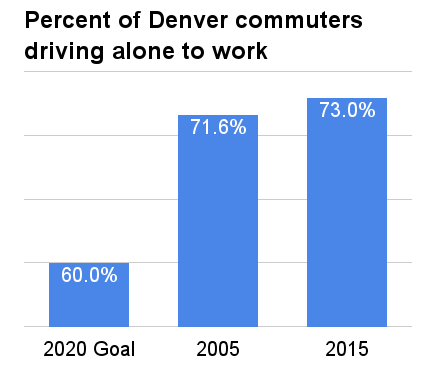WalkDenver: Hancock’s Budget “Reflects a Status Quo Mentality”

Last week Streetsblog looked at Mayor Michael Hancock’s proposed 2017 budget and was not impressed. Despite the mayor’s stated commitment to ending traffic deaths, he’s not committing much in the way of actual resources to safe walking and biking.
The pedestrian advocates at WalkDenver have been combing through the budget as well. In a newsletter published today, WalkDenver says that despite “a few wins for Denver residents yearning for more safe, healthy, and convenient transportation options, overall it falls short.”
While Hancock made good on some recommendations from the Vision Zero Coalition, his budget ignores Colfax Avenue, according to WalkDenver’s analysis, where five people were killed in traffic crashes last year.
Hancock’s budget “lacks vision and strategic thinking,” writes WalkDenver Program and Policy Director Jill Locantore, and will not help Denver reach goals like reducing solo car commuting to 60 percent of all commutes by 2020. Driving solo to work has only increased since 2005.
Head over to WalkDenver’s website for the entire analysis — it’s worth a read. Below are some highlights:
Ultimately, a lack of vision and strategic thinking.
The Mayor’s budget falls short of the funding needed not only for sidewalks, but for transportation infrastructure overall. As the City continues to grow by leaps and bounds – 1,000 new households move here every month – our transportation system has not kept up. Driving will inevitably get more difficult – there’s just a limit to how much space we can devote to cars in dense urban areas – which makes improvements to walking, biking and transit imperative.
Reflecting this reality, the Mayor’s 2020 Sustainability Goals include reducing trips in single-occupant vehicles (SOV) to no more than 60% of commutes. Recent data, however, shows the trend is in the wrong direction: the percent of workers in Denver who drove alone increased from 71.6% in 2005 to 73.0% in 2015. Reversing this trend will require a massive investment in pedestrian, bicycle, and transit infrastructure, to make up for decades of underinvestment in these modes.
About one third of the transportation funding in the Mayor’s budget is allocated to pedestrian, bicycle, and transit projects. While this is a substantial portion, the overall amount of funding for transportation projects – about $96 million out of a $1.92 billion budget – is woefully inadequate compared to the need.
As noted above, $475 million is needed just to build out the sidewalk network. Projects in the Denver Moves Bicycles Plan add up to $119 million, compared to only $2.2 million allocated in the 2017 budget. An untold amount is needed to build pedestrian and bicycle bridges over rivers, railroads, highways and other major barriers; to retrofit streets and intersections that are dangerous by design, encouraging speeding and other hazardous behaviors; and to provide frequent transit service to all Denver neighborhoods, not just between downtown and suburban communities. Clearly, the Mayor needs to grow the pie of funding available for transportation.
The Mayor could also allocate funding for walking, biking, and transit more wisely. While the budget includes laudable one-time projects such as improved access to bus stops in Globeville, Elyria, and Swansea – low-income neighborhoods that have suffered from severe disinvestment – the budget completely lacks a programmatic approach to building out the full network of sidewalks, bicycle lanes, safe crossings, and other multimodal improvements desperately needed throughout the City. This dearth of systematic thinking is perhaps most clearly illustrated by the allocation of $10 million for building curb ramps accessible to people in wheelchairs, which sounds great until you realize many of those curb ramps connect to substandard sidewalks inaccessible to people in wheelchairs, or to no sidewalk at all.
Overall, we are grateful to see Mayor Hancock allocating funding for projects that will make it safer and easier to get around Denver on foot, bike, or transit, but we’re disappointed to see such a low level of investment. The Mayor’s budget reflects a “status quo” mentality, not a vision for a world-class multimodal city. In the Mayor’s own words, “that takes vision, that takes leadership, and that takes significant investment.”


